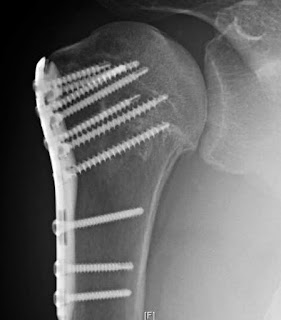A very active man in his 50s sustained a traumatic posterior fracture dislocation.
This was treated with open reduction internal fixation. An anatomic reconstruction was achieved. The patient achieved excellent function.
At a year after surgery the shoulder became painful and showed early signs of avascular necrosis as shown below.Two years after surgery, the humeral head had completely collapsed.
The axillary "truth" view shows screws penetrating the collapsed head and eroding the glenoid. His shoulder had essentially no motion at the glenohumeral joint.
Because of his active lifestyle, he elected to have a ream and run procedure. At surgery his humeral head looked like this.
The procedure was performed without a brachial plexus block. His biceps tendon was preserved.
His immediate postoperative films are shown below.
The axillary "truth" view shows his humeral head centered on the reamed glenoid.
On the morning after surgery he had regained excellent assisted motion as shown below.
It is most encouraging to see the early restoration of movement. This motivated patient should be able to maintain his motion with at home exercises.
After discharge on the second postoperative day he took his exercises outdoors
To see a YouTube video on how the ream and run is done, click on this link.
=====
To see our new series of youtube videos on important shoulder surgeries and how they are done, click here.
Use the "Search" box to the right to find other topics of interest to you.
You may be interested in some of our most visited web pages arthritis, total shoulder, ream and run, reverse total shoulder, CTA arthroplasty, and rotator cuff surgery as well as the 'ream and run essentials'










